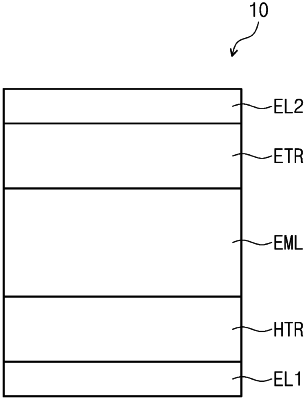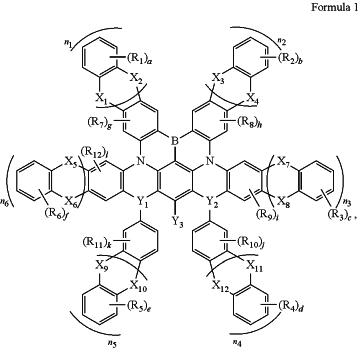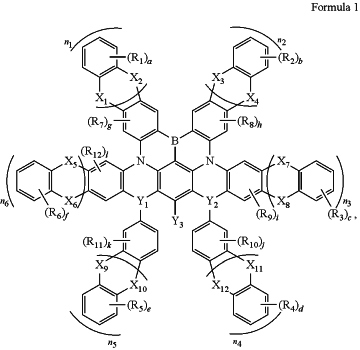| CPC H10K 85/656 (2023.02) [H10K 85/6572 (2023.02); H10K 85/6574 (2023.02); H10K 85/6576 (2023.02); H10K 50/12 (2023.02); H10K 50/15 (2023.02); H10K 50/16 (2023.02); H10K 50/805 (2023.02)] | 20 Claims |

|
1. An organic electroluminescence device, comprising:
a first electrode;
a hole transport region on the first electrode;
an emission layer on the hole transport region;
an electron transport region on the emission layer; and
a second electrode on the electron transport region,
wherein the first electrode and the second electrode each independently comprise Ag, Mg, Cu, Al, Pt, Pd, Au, Ni, Nd, Ir, Cr, Li, Ca, LiF/Ca, LiF/Al, Mo, Ti, In, Zn, Sn, a compound thereof, a mixture thereof, or an oxide thereof, and
the emission layer comprises a polycyclic compound represented by Formula 1:
 and
wherein in Formula 1,
Y1 and Y2 are each independently B, N, P═O or P═S,
X1 to X12 are each independently BAr1, O, S, NAr2 or a direct linkage,
Ar1 and Ar2 are each independently a substituted or unsubstituted aryl group of 6 to 30 carbon atoms for forming a ring, or a substituted or unsubstituted heteroaryl group of 2 to 30 carbon atoms for forming a ring,
Y3 and R1 to R12 are each independently selected from a hydrogen atom, a deuterium atom, a halogen atom, a substituted or unsubstituted amino group, a substituted or unsubstituted oxy group, a substituted or unsubstituted thio group, a substituted or unsubstituted alkyl group of 1 to 20 carbon atoms, a substituted or unsubstituted aryl group of 6 to 30 carbon atoms for forming a ring, or a substituted or unsubstituted heteroaryl group of 2 to 30 carbon atoms for forming a ring, and/or are bonded to one or more adjacent groups to form one or more rings,
“a” to “f” are each independently an integer of 0 to 4,
“j” and “k” are each independently an integer of 0 to 3,
“g” to “i” and “I” are each independently an integer of 0 to 2, and
n1 to n6 are each independently 0 or 1, where at least one among n1 to n6 is 1.
|
|
14. A polycyclic compound represented by the following Formula 1:
 wherein in Formula 1,
Y1, and Y2 are each independently B, N, P═O or P═S,
X1 to X12 are each independently BAr1, O, S, NAr2 or a direct linkage,
Ar1 and Ar2 are each independently a substituted or unsubstituted aryl group of 6 to 30 carbon atoms for forming a ring, or a substituted or unsubstituted heteroaryl group of 2 to 30 carbon atoms for forming a ring,
Y3 and R1 to R12 are each independent a hydrogen atom, a deuterium atom, a halogen atom, a substituted or unsubstituted amino group, a substituted or unsubstituted oxy group, a substituted or unsubstituted thio group, a substituted or unsubstituted alkyl group of 1 to 20 carbon atoms, a substituted or unsubstituted aryl group of 6 to 30 carbon atoms for forming a ring, or a substituted or unsubstituted heteroaryl group of 2 to 30 carbon atoms for forming a ring, and/or are bonded to one or more adjacent groups to form one or more rings,
“a” to “f” are each independently an integer of 0 to 4,
“j” and “k” are each independently an integer of 0 to 3,
“g” to “i” and “I” are each independently an integer of 0 to 2, and
n1 to n6 are each independently 0 or 1, where at least one of n1 to n6 is 1.
|